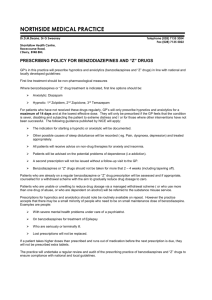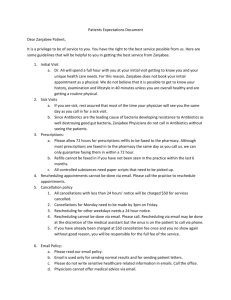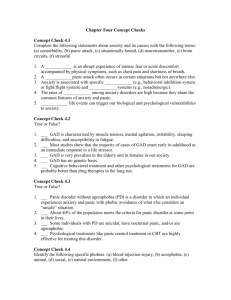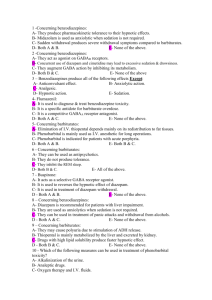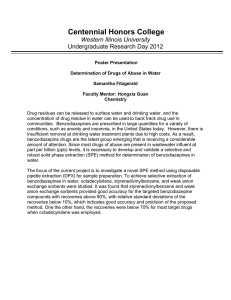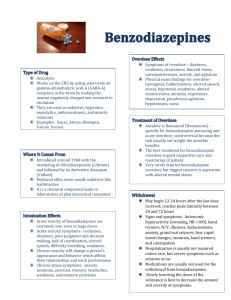Benzodiazepine Use: Anxiety, Sleep, Withdrawal & More
advertisement
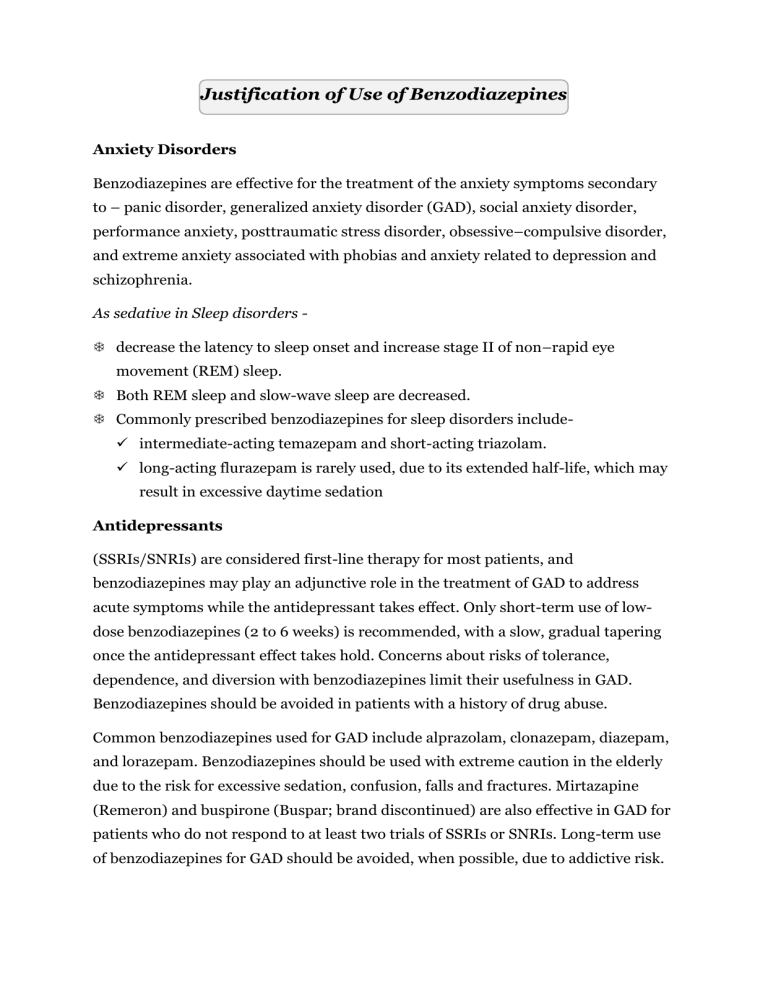
Justification of Use of Benzodiazepines Anxiety Disorders Benzodiazepines are effective for the treatment of the anxiety symptoms secondary to – panic disorder, generalized anxiety disorder (GAD), social anxiety disorder, performance anxiety, posttraumatic stress disorder, obsessive–compulsive disorder, and extreme anxiety associated with phobias and anxiety related to depression and schizophrenia. As sedative in Sleep disorders decrease the latency to sleep onset and increase stage II of non–rapid eye movement (REM) sleep. Both REM sleep and slow-wave sleep are decreased. Commonly prescribed benzodiazepines for sleep disorders include✓ intermediate-acting temazepam and short-acting triazolam. ✓ long-acting flurazepam is rarely used, due to its extended half-life, which may result in excessive daytime sedation Antidepressants (SSRIs/SNRIs) are considered first-line therapy for most patients, and benzodiazepines may play an adjunctive role in the treatment of GAD to address acute symptoms while the antidepressant takes effect. Only short-term use of lowdose benzodiazepines (2 to 6 weeks) is recommended, with a slow, gradual tapering once the antidepressant effect takes hold. Concerns about risks of tolerance, dependence, and diversion with benzodiazepines limit their usefulness in GAD. Benzodiazepines should be avoided in patients with a history of drug abuse. Common benzodiazepines used for GAD include alprazolam, clonazepam, diazepam, and lorazepam. Benzodiazepines should be used with extreme caution in the elderly due to the risk for excessive sedation, confusion, falls and fractures. Mirtazapine (Remeron) and buspirone (Buspar; brand discontinued) are also effective in GAD for patients who do not respond to at least two trials of SSRIs or SNRIs. Long-term use of benzodiazepines for GAD should be avoided, when possible, due to addictive risk. Alcohol Withdrawal Alcohol withdrawal is diagnosed in a patient with a history of heavy and prolonged alcohol use and a sudden reduction or complete abstinence from alcohol. Alcohol withdrawal produces changes in the body, such as: ✓ shakes or tremors ✓ sleeping difficulties ✓ confusion ✓ anxiety ✓ hallucination ✓ seizures ✓ delirium tremens Medications such as benzodiazepines are a first-line treatment for acute alcohol withdrawal. Benzodiazepines reduce withdrawal symptoms and may be life-saving for the patient. Commonly used medicines in this group include: chlordiazepoxide (Librium), diazepam (Valium), and lorazepam (Ativan). Lorazepam (Ativan) or oxazepam (Serax) may be preferred in patients with liver impairment such as cirrhosis. Chlordiazepoxide, diazepam, and lorazepam can be given orally, intravenously, or intramuscularly. Oxazepam may be useful but is only available orally. Insomnia Benzodiazepines are normally only used as a short-term treatment for severe insomnia, as they can lead to dependence. Benzodiazepines should be used for a short period of time (usually 2 to 4 weeks) for insomnia. Short-acting benzodiazepines are often preferred for insomnia because they theoretically produce less next-day drowsiness, although many patients still experience these effects. In general, patients should reassess their sleep habits -- avoid caffeine late in the day, limit electronics (TV, computer, mobile devices) in the bedroom and within 1-2 hours before bed, and avoiding alcohol consumption late in the evening. Exercise early in the day can often help to promote a more restful sleep; however, late-night exercise might be stimulating and have the opposite effect. IN Amnesia The shorter-acting agents are often employed as pre- medication for anxietyprovoking and unpleasant procedures, such as endoscopy, dental procedures, and angioplasty. Midazolam is used to facilitate amnesia while causing sedation prior to anesthesia. In Seizures Clonazepam is used as an adjunctive therapy for certain types of seizures lorazepam and diazepam are the drugs of choice in terminating status epilepticus. Due to cross-tolerance, chlordiazepoxide, clorazepate, diazepam, lorazepam, and oxazepam are useful in the acute treatment of alcohol withdrawal and reduce the risk of withdrawal-related seizures. Muscular Disorders Diazepam is useful in the treatment of ✓ skeletal muscle spasms, such as occur in muscle strain. ✓ spasticity from degenerative disorders, such as multiple sclerosis and cerebral palsy. ✓ In convulsive disorder like tetanus, eclampsia and epilepsy as skeletal muscle relaxants. ✓ In anesthetic premedication and night terrors. Muscle Relaxant The skeletal muscle relaxant class, which includes agents such as baclofen, carisoprodol (Soma), methocarbamol (Robaxin), metaxalone (Skelaxin), and cyclobenzaprine (Flexeril), are typically used first-line when a muscle-relaxing effect is needed. Benzodiazepines such as diazepam may be used short-term as muscle relaxants reducing the tone of skeletal muscle. These are generally used to relieve painful skeletal muscle spasms, such as what might occur with acute lower back pain. Panic Disorders Panic disorder is a specific type of anxiety disorder. A person with panic disorder has panic attacks which are repeated episodes of intense fear which may be expected or unexpected. These symptoms may be accompanied by physical symptoms that are similar to the body's normal response to danger, often called the "fight or flight" phenomenon. Panic attacks may accompany other mood disorders such as depression, anxiety or substance abuse conditions. Symptoms may include✓ rapid heart rate ✓ trembling or tingling sensation ✓ flushing, redness and sweating ✓ shortness of breath ✓ fear and heightened awareness of surroundings, even if no danger is present ✓ worry about death or losing control ✓ avoidance of crowds or other public spaces due to fear of impending attack (agoraphobia). Panic disorder can be a prolonged, chronic disorder, but it is very treatable with medications that lessen symptoms. Behavioral therapy and treatment with the antidepressants such as selective serotonin-reuptake inhibitors (SSRIs), serotoninnorepinephrine reuptake inhibitors (SNRIs), and/or behavioral therapy are first-line treatments. The older tricyclic antidepressants, such as nortriptyline (Pamelor) and imipramine (Tofranil) are effective, too, but may be hindered by drowsiness and anticholinergic drug side effects, which can be especially problematic for older patients. In those without co-existing conditions such as depression or a history of substance abuse, benzodiazepines may be used cautiously for a short period of time.
